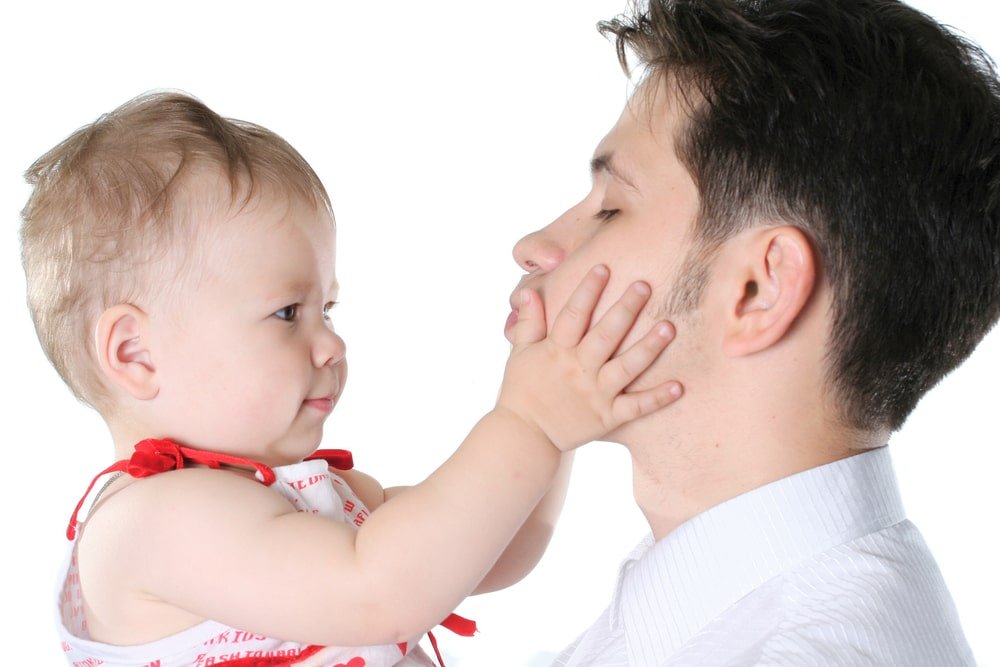Have you ever noticed a baby’s tiny fingers reaching out to grasp your face, perhaps with surprising strength or determination? This adorable yet curious behavior is a common occurrence in infancy and often leaves caregivers wondering about its significance. In this insightful guide, we’ll explore the reasons behind why babies grab your face, shedding light on the sensory, social, developmental, and emotional factors that contribute to this behavior. By understanding the motivations behind facial grabbing, caregivers can foster deeper connections with their little ones and provide appropriate support and responses.
Sensory Exploration and Stimulation
From the moment they are born, babies embark on a journey of sensory discovery, eagerly exploring the world around them through touch, sight, sound, and smell. Facial grabbing is one way infants engage in tactile exploration, using their developing motor skills to reach out and touch the faces of their caregivers. The soft and pliable skin of the face provides a rich sensory experience for babies, offering tactile feedback and stimulation that enhances their understanding of the world.
As infants grasp and touch their caregivers’ faces, they receive sensory input that helps refine their developing sense of touch and spatial awareness. The sensation of skin against skin, the contours of facial features, and the warmth of human touch all contribute to a pleasurable sensory experience for babies. This tactile stimulation not only fosters physical development but also strengthens the bond between caregiver and child as they engage in this intimate form of interaction.
Social Interaction and Bonding
Beyond the realm of sensory exploration, facial grabbing serves an important social function for infants, facilitating communication and bonding with their caregivers. From the earliest moments of life, babies are wired to seek out social interactions and connections with others, as these interactions play a crucial role in their emotional and cognitive development. By grabbing their caregivers’ faces, infants signal a desire for attention, interaction, and emotional connection.
Facial grabbing is often accompanied by eye contact, smiles, and vocalizations, creating a dynamic exchange of social cues between caregiver and child. As caregivers respond sensitively to their baby’s cues, engaging in reciprocal interactions and affectionate gestures, they reinforce the emotional bond between them. This early form of social interaction lays the foundation for healthy attachment and fosters a sense of security and trust in the caregiver-child relationship. By responding warmly and attentively to facial grabbing behavior, caregivers can nurture their baby’s social and emotional development while strengthening the bond between them.
Developmental Milestones and Cognitive Growth
Facial grabbing also plays a pivotal role in infants’ developmental milestones and cognitive growth. As babies begin to master their motor skills, including grasping and reaching, they naturally gravitate towards objects within their reach, including their caregivers’ faces. This behavior represents an exciting milestone in their physical development, as they learn to coordinate their movements and manipulate objects in their environment.
Furthermore, facial grabbing offers infants an opportunity to engage in cognitive exploration and recognition of facial features. As they touch and explore their caregivers’ faces, infants begin to develop an understanding of facial expressions, emotions, and identities. Through repeated interactions, they learn to recognize familiar faces and distinguish between different facial features, laying the groundwork for future social and cognitive development.
By encouraging and supporting infants’ efforts to grab and explore their caregivers’ faces, caregivers play an active role in promoting their overall development and cognitive growth. Providing infants with opportunities for sensory exploration and tactile stimulation fosters curiosity, curiosity, and curiosity, which are essential qualities for learning and development. As infants continue to explore and interact with their environment, they build upon their foundational skills and abilities, paving the way for future milestones and achievements.
Emotional Expression and Regulation
In addition to serving as a means of sensory exploration and social interaction, facial grabbing also serves as a form of emotional expression and regulation for infants. During moments of distress or discomfort, infants may instinctively reach out to their caregivers’ faces for comfort and reassurance. The act of grasping their caregivers’ faces provides a sense of security and closeness, helping infants regulate their emotions and soothe themselves during times of stress.
Furthermore, facial grabbing allows infants to express their emotions and needs nonverbally, communicating their desire for attention, affection, or comfort. By reaching out to their caregivers’ faces, infants signal a need for closeness and connection, seeking solace in the familiar touch and presence of their primary caregivers. In response, caregivers can offer gentle reassurance, soothing words, and comforting gestures to help calm and comfort their baby.
By recognizing and responding sensitively to their baby’s cues, caregivers can support their emotional development and foster a secure attachment relationship. By providing a safe and nurturing environment where their emotional needs are met, infants learn to trust and rely on their caregivers, laying the foundation for healthy emotional development and secure attachment bonds. Through moments of facial grabbing and emotional expression, caregivers and infants forge a deep and lasting connection built on love, trust, and mutual understanding.
Cultural and Individual Variations
It’s essential to acknowledge that the significance and interpretation of facial grabbing behavior may vary across different cultures and individual circumstances. Cultural differences in caregiving practices, societal norms, and attitudes towards physical touch can influence how facial grabbing is perceived and responded to by caregivers. In some cultures, physical contact and affection are highly valued and encouraged, while in others, personal space and boundaries may be more pronounced.
Individual differences in infant behavior, temperament, and personality traits can also shape the frequency and intensity of facial grabbing behavior. Some infants may be more inclined to engage in tactile exploration and social interaction, while others may be more reserved or cautious in their interactions with caregivers. Additionally, parent-child attachment styles and dynamics can influence how caregivers respond to facial grabbing behavior, with some parents being more responsive and attuned to their baby’s cues than others.
By recognizing and respecting cultural and individual variations in facial grabbing behavior, caregivers can respond sensitively and effectively to their baby’s needs and preferences. By adopting a culturally sensitive and child-centered approach to caregiving, caregivers can create a supportive and nurturing environment where their baby feels safe, loved, and understood.
Practical Tips for Responding to Facial Grabbing
For caregivers navigating the world of facial grabbing behavior, here are some practical tips for responding sensitively and effectively:
- Be observant: Pay attention to your baby’s cues and body language to understand their needs and preferences.
- Be responsive: Respond promptly and warmly to your baby’s facial grabbing behavior, offering comfort, affection, and reassurance.
- Be patient: Allow your baby to explore and engage in facial grabbing behavior at their own pace, respecting their autonomy and individuality.
- Be affectionate: Show your love and affection through gentle touches, cuddles, and affectionate gestures, reinforcing the emotional bond between you and your baby.
- Be present: Be fully present and engaged during interactions with your baby, offering your undivided attention and affection.
By following these tips and guidelines, caregivers can create a supportive and nurturing environment where their baby feels safe, loved, and understood. Through responsive and sensitive caregiving, caregivers can foster healthy emotional development, secure attachment bonds, and a lifelong connection with their baby.
In conclusion, the act of facial grabbing in infants serves multiple purposes, ranging from sensory exploration and social interaction to developmental milestones and emotional expression. Through the gentle touch of their caregivers’ faces, infants engage in a rich sensory experience that enhances their understanding of the world and strengthens the bond between caregiver and child. Facial grabbing also represents a significant developmental milestone as infants begin to master their motor skills and recognize familiar faces and expressions.
Furthermore, facial grabbing serves as a form of emotional expression and regulation for infants, providing comfort and reassurance during moments of distress or discomfort. By responding sensitively and affectionately to their baby’s cues, caregivers can support their emotional development and foster a secure attachment relationship. Ultimately, the act of facial grabbing is a natural and meaningful behavior that reflects the deep bond between caregiver and child, laying the foundation for a lifetime of love, trust, and connection.
FAQs (Frequently Asked Questions) – Why Do Babies Grab Your Face?
1. Is facial grabbing behavior in babies a cause for concern?
- Facial grabbing behavior is a common and typically harmless behavior in infants. It is often a sign of curiosity, social interaction, and sensory exploration. However, if facial grabbing is accompanied by excessive force or aggression, or if it is accompanied by other concerning behaviors, it may be worth discussing with a pediatrician or healthcare professional.
2. What should I do if my baby’s facial grabbing behavior becomes too intense or aggressive?
- If your baby’s facial grabbing behavior becomes too intense or aggressive, it’s essential to respond calmly and gently. Redirect your baby’s attention to a more appropriate activity or toy, and reinforce positive behavior through praise and encouragement. If the behavior persists or escalates, seek guidance from a pediatrician or healthcare professional for further evaluation and support.
3. How can I differentiate between normal facial grabbing behavior and signs of discomfort or distress in my baby?
- Normal facial grabbing behavior in babies is typically accompanied by curiosity, exploration, and social interaction. Babies may reach out to touch their caregivers’ faces during moments of play or bonding. Signs of discomfort or distress, on the other hand, may include crying, fussiness, or physical resistance. It’s essential to pay attention to your baby’s cues and body language to understand their needs and respond appropriately.
4. Is there a specific age range when facial grabbing behavior is most common in infants?
- Facial grabbing behavior can occur at various stages of infancy, depending on individual developmental timelines and motor skill development. It often emerges in the early months of life as infants begin to explore their surroundings and interact with their caregivers. While facial grabbing may be more common in younger infants, it can continue into the toddler years as part of ongoing sensory exploration and social interaction.
5. How can I encourage positive facial grabbing behavior in my baby?
- To encourage positive facial grabbing behavior in your baby, provide opportunities for sensory exploration and social interaction. Engage in face-to-face interactions, maintain eye contact, and respond warmly and attentively to your baby’s cues. Offer praise and encouragement for gentle and affectionate interactions, reinforcing the bond between caregiver and child.









